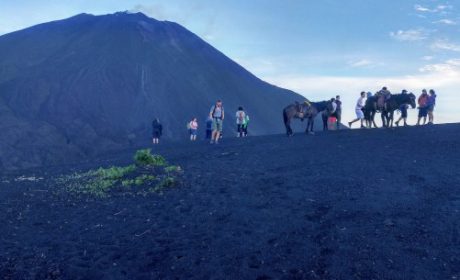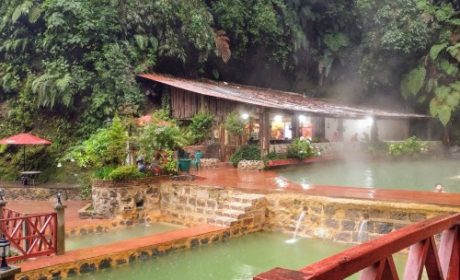Family travel can be tough, especially when it involves multiple generations. However, if you throw in an amazing destination, active travel and the threat of perishing in an active volcano, well, it will always be a memorable vacation if nothing else. For instance, our guest contributor, Vickie Lillo recently took her family on an adventure of a lifetime, hiking Nicaragua’s Telica Volcano.
An active volcano about 18 miles from the capital, the Telica Volcano last erupted in 1948. But … it continues to smoke and rumble as if it’s just waiting for the right moment to explode. Vickie is here today to tell us all about her family’s incredible hiking adventure, trekking up the volcano, camping at its base and stopping at the famed hot springs of San Jacinto.
Hiking Nicaragua’s Telica Volcano
“Lote, lote, lote!” the grizzled Nicaraguan woman chanted as she maneuvered among the throngs of human flotsam straddling the aisles of our chicken bus.
“Lote…siete córdobas.” Corn. Teaming hot corn-on-the-cob. Savory goodness for only seven córdobas, barely more than a quarter. Her gnarled fingers plucked one last ear from the bucket – for that final sale – before making a swift exit down the steps. My husband Gustavo and I were wedged tight as sardines into our seats, while our son Nicolas and our tour guide Florian from Sonati Tours clung to the overhead rail.

I clenched a bag of rosquillas (delicious corn snacks, the local specialty from Somoto Canyon) with one hand and braced myself with the other as we lurched out of the station, away from the hub of downtown Léon, toward the bubbling mud pots at los Hervidores de San Jacinto.
If you’re looking to plan your own Nicaraugua, adventure, use Leon as a base to start your exploration. Start your search for hotels in Leon, Nicarauga with us!

Scrambling from our cramped position upon arrival, we wrangled on our backpacks and followed the hordes, in the direction of the steaming hot springs. A concrete walkway yawned ahead; we traipsed along until it stopped abruptly, at a barren patch of volcanic terrain. Barren save for occasional rocks and cracked patches of earth that ringed each of the scalding pools of mud. So impressive…this raw and unrefined power of Mother Earth simmering just beneath our feet.

With a last backwards glance at the trailhead here at these boiling puddles of muck, we left the crowds behind and set off toward Volcán Telica. The double crater of Telíca – an active conical volcano and our proposed camping site for the evening.
Hiking the Telica Volcano

Through glens and valleys we hiked. Past bean fields and farmers plowing the rows by hand. Past guanacaste trees and an occasional ceiba, both sacred árboles of the Mayas, we trekked. Into the rainforest. We lumbered along a narrow path, flanked on both sides by impenetrable underbrush and hardwoods that grew towards the skies. Their outstretched limbs were draped in curtains of vibrant greenery, courtesy of creeping vines and flowering epiphytes.

In spite of this verdant canopy of trees and foliage, the heat was intense. Almost wicked. Liter after liter of our water supply disappeared down our parched throats—to fight off dehydration—and a couple more doused the top of my head—to fend off my collapse.

Fortunately, after nearly six hours of ascent, the southern crest of the volcano, a vent now covered in basalt, was only a short climb further. Through brambles and tall weeds, around outcroppings of rock … to its incredible mirador (overlook). Straddling that ridge, the four of us, with our faces turned to the blustering Pacific winds, could see Nicaragua’s entire spuming mountain chain.
Downwind from the Dragon’s Lair
Known as the famed Cordillera de los Maribios, it represents a line of lava-expelling ruptures in the earth’s crust that lays on the infamous ‘Ring of Fire’ – a horseshoe-shaped oceanic basin of seawater riddled with continuous belts of active volcanoes, stretching from Australia to Chile’s Tierra del Fuego. In the dimming light of late afternoon, beads of golden sunshine flickered across the distant cones of San Cristóbal, the tallest stratovolcano in the country, and Momotombo.

In less than sixty minutes, in a velvety pasture carpeted with thick grass, in a grove of coconut palms, we prepared our palace for the night. Pitching our tents just a stone’s throw from the lair of a fire-breathing dragon. Even as he slept, thankfully, the distant rumble of his snores echoed through the meadow, and spires of steam billowed from his nostrils.
Peering into the Belly of the Beast
As dusk came and went and night settled upon our campsite, we rifled through our rucksacks in search of flashlights. Our intention: to dangle over the precipice, along the edge of the caldera, and gaze down into the belly of the beast. Without any stars to guide the way—extinguished by an earlier bout of torrential rain—we had to rely solely on the faint lumens of our torches. And our guide’s expertise.
Inspired to get hiking? Check out our many articles on hiking around the world!
Florian swung his beacon in a wide arc. We saw an emaciated wild horse skulking amongst the remains of pyroclastic rubble. Ghostly, with an almost translucent pallor, he nibbled at tiny growths of moss. A nearby pool of water from that aforementioned thundershower offered temporary sanctum to scores of croaking bullfrogs. They sang lustily, their symphony rising to a crescendo at our approach. “We’re almost to the edge,” our leader cautioned. From here, we dropped to our bellies and crawled commando style towards the pit.
At the mouth of the crater, we carefully peered into the dragon’s nest. Glowing red embers of scoria—like the winking crimson eye of a Cyclops—glowered at us from deep within the lair.A poof of sulfuric smoke followed, discharged from the molten mountain through Draconian lungs, which sent us on a hasty retreat back to the security of our camp.
Slumbering Next to the Dragon
Exhausted from the day’s climb, I crawled into my sleeping bag and drifted off to deep repose, soothed to sleep by the never-ending chirrup of insect chatter, the crackle of dying embers from our bonfire, and the rustling of our tent canvas flapping in the breeze. A seismic breeze that filtered in and out of the smoldering cordillera as a dense fog…creeping through our bivouac of greenery like a ninja in camouflage.Though faint, I could still smell the beast’s nasty breath. Lingering in that wind. Coughed up from a 1078°F river of magma deep inside his haunt.I should have felt a sensation of genuine fear, to be this remote, this completely off the beaten path. Yet, it was peaceful, and strangely quiet, dozing next to the dragon.
In the dawn of a 5:30 a.m. sunrise, rays of gilded light played across the double crater of Telíca, bathing the surrounding vegetation – both misshapen, twisted tree limbs devoid of bark and flowering shrubs – in a fiery afterglow.

Even as I strapped on my gear and mentally prepared for the brutal trek back down, I smiled … few people would ever have the gumption or the physical fortitude to venture to the simmering caldera of Volcán Telica. Fewer still would ever pitch a tent at its growling base. But my family and I now had a memory that could never be erased, and moments trapped in time that no amount of money could ever buy.

With that, I humbly bowed my head and bid adiós to the chimera, still deep in slumber, and started off toward town. Toward the burbling mud pots at El Jacinto. A half-hearted wave over our shoulders, to that dragon who lie snoring, and we were on our way. A bumpy ride in the rear of a box truck this time – no garish chicken bus – delivered us safely those 12 miles back to Léon. And a lunchtime siesta relaxing in a hammock at our charming hostel, Colibri Leon.
Disclosure* None of the trip was subsidized in any way. The prices were so cheap, and with the monies going towards eco-tourism and education of local schoolchildren, I couldn’t really bring myself to even ask for a discount.
Did you know that we publish a weekly broadcast with the latest articles from My Itchy Travel Feet, timely trip inspiration and travel deals? Subscribe by clicking here.


